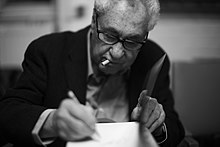This is an old revision of this page, as edited by 216.19.183.88 (talk) at 22:57, 2 January 2014 (link dogs -> dog). The present address (URL) is a permanent link to this revision, which may differ significantly from the current revision.
Revision as of 22:57, 2 January 2014 by 216.19.183.88 (talk) (link dogs -> dog)(diff) ← Previous revision | Latest revision (diff) | Newer revision → (diff)
Elliott Erwitt (b. 26 July 1928 Paris, France) is an advertising and documentary photographer known for his black and white candid shots of ironic and absurd situations within everyday settings— a master of Henri Cartier-Bresson's "decisive moment".
Early life
In 1939, at the age of ten, Erwitt's family, of Russian origin, immigrated to the United States. Erwitt studied photography and filmmaking at Los Angeles City College and the New School for Social Research, finishing his education in 1950.
Photography career
Born in Paris of Jewish-Russian immigrant parents, Erwitt served as a photographer's assistant in the 1950s in the United States Army while stationed in France and Germany. Erwitt was influenced by his meeting the famous photographers, Edward Steichen, Robert Capa and Roy Stryker. Stryker, the former Director of the Farm Security Administration's photography department, hired Erwitt to work on a photography project for the Standard Oil Company. Erwitt then began a freelance photographer career and produced work for Collier's, Look, Life and Holiday. Joining the Magnum Photos agency in 1953 allowed Erwitt to shoot photography projects around the world.
One of the subjects Erwitt has frequently photographed in his career is dogs: they have been the subject of four of his books, Son of Bitch (1974), Dog Dogs (1998), Woof (2005) and Elliott Erwitt's Dogs (2008).
More recently, Erwitt has created an alter ego, the beret-wearing and pretentious André S. Solidor (which abbreviates to "ass") — "a contemporary artist, from one of the French colonies in the Caribbean, I forget which one", in order to "satirise the kooky excesses of contemporary photography". The work of said alter-ego was published in a book, The Art of André S. Solidor (2009), and exhibited in 2011 at the Paul Smith Gallery in London.
He was awarded The Royal Photographic Society's Centenary Medal and Honorary Fellowship (HonFRPS) in recognition of a sustained, significant contribution to the art of photography in 2002.
Filmmaking career
Since the 1970s, he has devoted much of his energy toward movies. His feature films, television commercials, and documentary films include "Arthur Penn: the Director" (1970), Beauty Knows No Pain (1971), Red, White and Bluegrass (1973) and the prize-winning Glassmakers of Herat, Afghanistan (1977). He was, as well, credited as Camera Operator for "Gimme Shelter" (1970), Still Photographer for Bob Dylan: No Direction Home (2005), and provided Addition Photography for "Get Yer Ya Ya's Out (2009).
A collection of Erwitt's films were screened in 2011 as part of the DocNYC Festival's special event "An Evening with Elliott Erwitt". Erwitt was himself profiled in a documentary film, which appeared in the same festival, titled "Elliott Erwitt: I Bark at Dogs" - directed by Douglas Sloan (filmmaker).
Notable photographs
- USA, New York City, 1946 - Streetlevel shot comparing the size of a woman's feet to a sweatered chihuahua.
- USA, North Carolina, Segregated Water Fountains, 1950.
- USA, New York City, 1953 - Image of Erwitt's wife looking at their baby on a bed lit by window light.
- USA, NYC, Felix, Gladys, and Rover, 1974 - Image of a woman's booted feet between that of a Great Dane's legs and a little chihuahua.
- USSR, Russia, Moscow, Nikita Khrushchev and Richard Nixon, 1959 - Powerful Cold War image in which Nixon is poking his index finger at Khrushchev's suit lapel.
- USA, California, 1955 - Image of a side-view mirror of an automobile parked facing a beach sunset, with a playful couple shown in the mirror as the focal point.
Books
- Photographs and Anti-Photographs, 1972.
- Observations on American Architecture, 1972.
- Elliott Erwitt: The Private Experience. (In the series "Masters of Contemporary Photography", text by Sean Callahan.) Los Angeles: Petersen, 1974. ISBN 0-8227-0070-0 Sean Callahan describes and to some extent explains Erwitt's work.
- Son of Bitch, 1974. Photographs of dogs.
- Recent Developments, 1978.
- Personal Exposures. 1988.
- On the Beach, 1991.
- To The Dogs, 1992.
- The Angel Tree, 1993.
- Between the Sexes, 1994.
- 100+1 Elliott Erwitt, 1997.
- Dog Dogs, 1998 A collection of black and white photographs of dogs Erwitt was intrigued by throughout his world travels.
- Museum Watching, 1999.
- Snaps. London & New York: Phaidon, 2001. ISBN 0-7148-4150-1 A large anthology (over 500 pages) of Erwitt's work.
- EE 60/60, 2002.
- Elliott Erwitt's Handbook, 2002.
- Woof, 2005.
- Elliott Erwitt's Rome:teNeues Publishing, 2009
- Elliott Erwitt's New York', 2009
- The Art of Andre S. Solidor aka Elliott Erwitt, 2010
- Elliott Erwitt Personal Best, 2010
- Elliott Erwitt, Sequentially Yours, 2011
- Elliott Erwitt XXL - Special and Collectors Edition, 2012
References
- ^ Cripps, Charlotte (10 February 2011). "A drastic change of image: Magnum photographer Elliott Erwitt has crafted a glorious alter ego". The Independent. Retrieved 24 April 2011.
- "Who is André S. Solidor?". The Week. 10 February 2011. Retrieved 24 February 2011.
- Royal Photographic Society's Centenary Award
- "An Evening with Elliott Erwitt". DocNYC. Retrieved Nov 10 2011.
{{cite web}}: Check date values in:|accessdate=(help)
External links
- Elliott Erwitt official site requires Flash
- Magnum Photos portfolio
- Robert Koch Gallery portfolio
- "Elliott Erwitt at the Museo di Roma," Financial Times (London), November 20 2009
- Peter Conrad, Elliott Erwitt's law of intended consequences, The Observer, 20 February 2011
- ' NY Times article about the exhibition May to August at the ICP, New York City
- Elliott Erwitt's Personal Best eBook, 2011
- Elliott Erwitt's print archive is placed at the Harry Ransom Center at The University of Texas at Austin